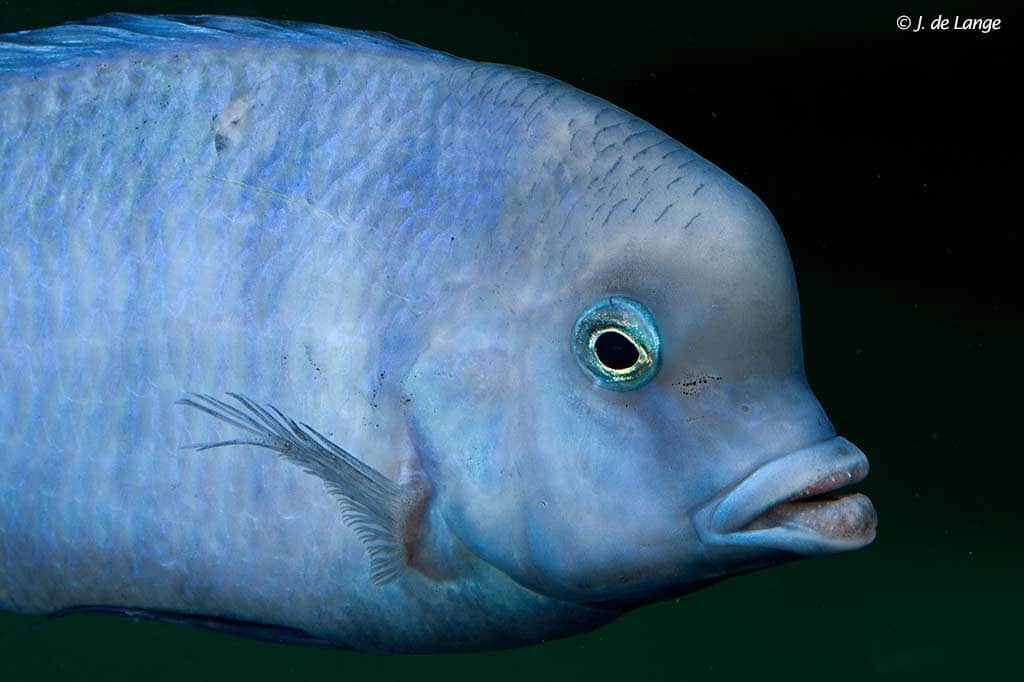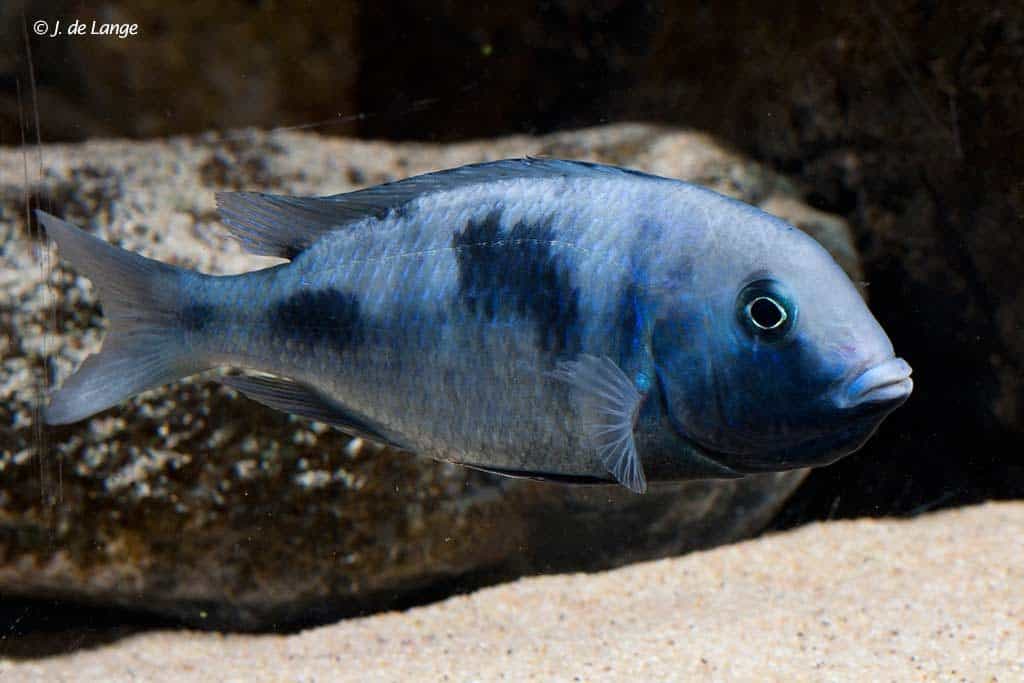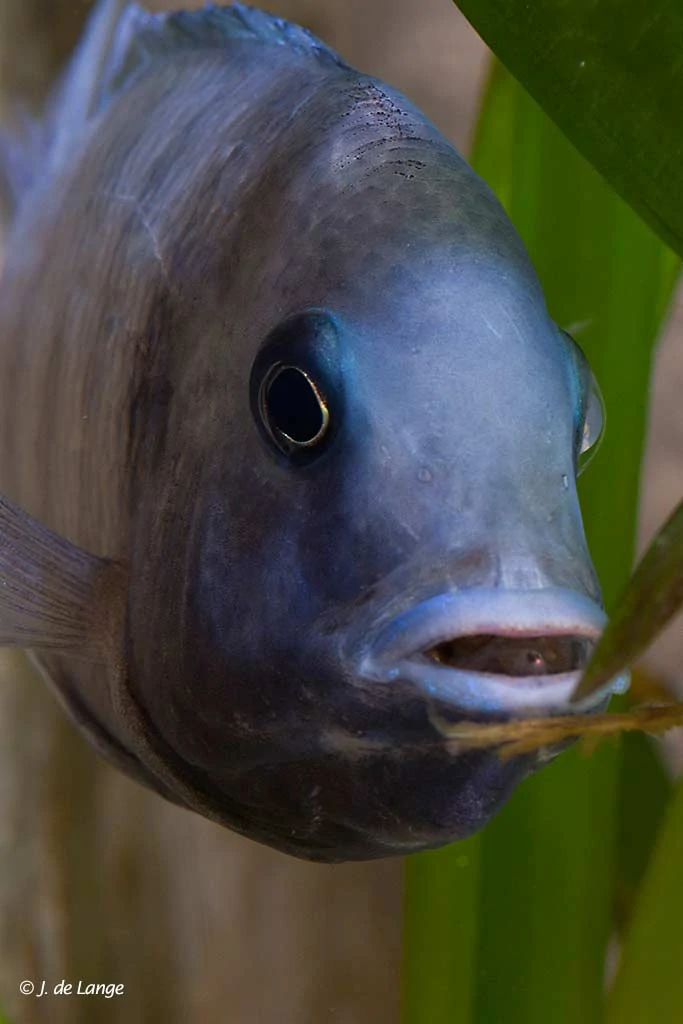Cyrtocara moorii – Blue Dolphin Cichlid
Cyrtocara moorii was first described by Boulenger in 1902 as Haplochromis moorii. In 1989, Eccles and Trewavas gave it their own family name Cyrtocara, in which it also resides as the only one. In English they are referred to as Blue Dolphin Cichlid, they sometimes resemble a dolphin in terms of color and shape.
We can find the following names as synonyms: Haplochromis moorii, Cyrtocara moorei, Cyrtocara moori and Haplochromis moori.
The name Cyrtocara comes from ancient Greek and means bent head as a reference to the hump that the males can develop. Moorii refers to J. Moore who first discovered this species.
Description
Young Cyrtocara moorii are greyish with cross stripes. When they grow up, both the male and female are pale blue with three spots on the flank. Depending on their mood, the fish are this pale blue to bright blue with the spots completely disappeared. Especially dominant or mating males change to dark blue, normally they are also lighter blue and show three dark spots on their flanks.
Males and females are in general almost the same colour, this is already an indication that these fish can get along fairly well with each other. These fish show the best behaviour when they are kept in a group. You can hold several males and females in that group.

Biotope
In Lake Malawi, Cyrtocara moorii mainly inhabits sandy soils but is also found in the transitional biotopes between rocks and sand. They are mainly found in shallow water of about 3 meters in depth. They are generally fish that occur solitary, you will not find large groups in Lake Malawi. They do occur throughout the lake, with no differences to be found between the specimens caught in the north or south of the lake.
Cyrtocara moorii can also be found in Lake Malombe. Lake Malombe is supplied by the Shire from Lake Malawi.
Catching Cyrtocara moorii in Lake Malawi
Although Cyrtocara moorii occurs throughout Lake Malawi, it does not occur in large numbers anywhere. They live in fairly shallow water above the sand, so you would expect them to be fairly easy to catch. However, fishermen have to put in a lot of effort to catch the Dolphin Cichlid. They are smart and fast enough to avoid the fishermen’s nets. They stay far away from the fisherman, unlike many other fish species. Wild-caught fish are therefore almost exclusively caught when visibility in the water is obscured by, for example, wind and current. If you want to buy Cyrtocara moorii, aquarium bred specimen are often available.
Diet
In the wild, the Cyrtocara moorrii feeds exclusively by following the Fossorochromis rostratus, Mylochromis lateristriga and the Taeniolethrinops praeorbitalis. These three fish feed on themselves by digging in the sand, sieving the sand through their gills. During this process, a lot of sand and mud drifts, exposing small crustaceans and other small food. Very interesting is that Cyrtocara moorii defended its “host” against other Moorii’s and other followers (eg Protomelas annectens).
In the aquarium, the Cyrtocara moorii is an easy eater, flake food, granulate etc is eaten but this should be alternated with frozen or live food such as mysis, krill etc. No tubifex or red mosquito but this actually applies to all Malawi cichlids. Also, make sure that you do not feed too much. Too much and protein-rich food can ensure that this species can grow to 30 centimetres, especially in the males. All Malawi cichlids are actually greedy eaters, because of our powerful food they easily grow too large.
The Aquarium
It goes without saying that Cyrtocara moorii needs a generous size aquarium. The aquarium must be decorated with fine sand and some rocks on the bottom so that in particular females can temporarily escape the attention of males.
When the Cyrtocara just entered the aquarium trade, it was soon called a hard-to-keep fish, partly because of his behaviour but also because the mortality rate was high. Today we keep large cichlids in much larger aquariums than in the past. The water change is also known to everyone. So make sure you have a spacious aquarium and refresh the water regularly, this certainly contributes to the health of your Cyrtocara mooriis.
Spawning Tank and Conditioning
To breed Cyrtocara moorii, a separate aquarium is not needed. A spacious aquarium with sand on the bottom, a few rocks and the correct water parameters are sufficient. They can also be bred in aquariums with other adult Malawi cichlids. Because it is a mouthbrooder, the female protects the young in the first phase of life.
The spawn
Breeding the Cyrtocara moorii is not too difficult in itself, a pair will quickly mate as soon as they become adults. Mating proceeds as with many Malawi cichlids. The male looks for a place to spawn. Normally they do not defend their territory, but for spawning they make a temporary exception and defend their chosen spot. He lures the female to him. The male and female circle around each other, with the female putting her nose near the anal fin, even though the male has no egg spots. The female lays a few eggs, turns around and takes the eggs in her mouth, after which the cirling around each other continues.
Raising the fry
As mentioned, the female hatches the young Cyrtocara moorii in her mouth. So they are mouthbreeders. The female does not eat during incubation. The eggs hatch after a few days, but the young fish do not leave the mouth. They continue to live on the egg yolk sac for quite some time.
After about 17 or 18 days the female can release the young. To do this, she looks for a quiet place and lets the fry swim loose. In case of danger or at night, the young are taken back into the mouth to protect them. The nests often consist of 40 to 80 young. The fry can be fed with finely rubbed flakes and brine shrimp. In order for the young to grow well, it is also important for this species to change the water regularly.

Breeding aquarium
In an aquarium with other adult fish, the young fish are often eaten. If you want to keep more young or a whole nest, it is best to catch the female. Then place her in an aquarium without other fish. Furnish this with some sand, a few rocks where the female can hide and keep the water values approximately the same as the normal aquarium. Place the female in this after about 15 days of incubation.
Catching and moving the females with their mouths full is quite a challenge. Not all females hold the eggs well when being caught, so careful and calm collection with a sufficiently large net is important. If necessary, only do this on day 15 or 16. If the female then releases the fry and does not take them back into her mouth, then the young are big enough to grow up without their mother. However, not all females release the young as easily, some mothers hold the young in their mouth until day 25.
You can start feeding the female when she lets the fry go. If she no longer takes the fry back into her mouth, you can place the female back in the main aquarium.
Video
Author
John de Lange
Copyright images




























Reviews
There are no reviews yet.